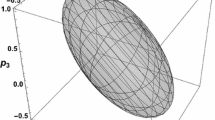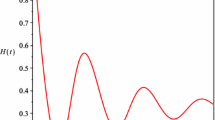Abstract
If the early universe was highly anisotropic, primordial black holes may have formed prolifically (despite previous claims to the contrary) even if the initial density fluctuations were small. However, the holes would initially be endowed with an immense amount of shear, so it is not obvious that they would evolve into the conventional type ofstationary black hole envisaged by the “no hair” theorem. If they do settle down to a stationary state, it may only be on a considerable time scale; and in principle there might exist soliton-type solutions which represent holes with shear which persists indefinitely. Such “shear hell holes,” as we term them, could have even more dramatic properties than the usual stationary holes: in particular, they might be prolific generators of gravitational radiation and they could be associated with interesting quantum effects.
Similar content being viewed by others
References
Israel, W. (1967).Phys. Rev.,164, 1776.
Carter, B. (1970).Phys. Rev. Lett.,26, 331.
Hawking, S. W. (1972).Commun. Math. Phys.,43, 199.
Robinson, D. C. (1974).Phys. Rev. D,10, 458.
Misner, C. W. (1969).Phys. Rev. Lett.,22, 1071.
Kasner, E. (1921).Am. J. Math.,43, 217.
Belinskii, V. A., Khalatnikov, I. M., and Lifschitz, E. M. (1970).Advan. Phys.,19, 525.
Barrow, J. D., and Carr, B. J. (1978).Mon. Not. R. Astron. Soc.,182, 537.
Perko, T. E. Matzner, R. A., and Shepley, L. C. (1972).Phys. Rev. D,6, 969.
Carr, B. J. (1975).Astrophys. J.,201, 1.
Doroshkevich, A. G., Zel'dovich, Ya. B., and Novikov, I. D. (1966).Sov. Phys. JETP,22, 122.
Price, R. H. (1972).Phys. Rev. D,5, 2419;5, 2439.
Chandrasekhar, S., and Detweiler, S. (1975).Proc. R. Soc. London Ser. A,344, 441.
Cunningham, C. T., Moncrieff, V., and Price, R. H. (1978).Astrophys. J.,224, 643.
Misner, C. W., Thorne, K. S., and Wheeler, J. A. (1973).Gravitation (Freeman & Co., San Francisco).
Scott, A. C., Chu, F. Y., and McLaughlin, D. W. (1973).Proc. IEEE,61, 1443.
Belinskii, V. A., and Zakharov, V. E. (1978).Sov. Phys. JETP,48, 985.
Hawking, S. W. (1974).Nature,248, 30.
Author information
Authors and Affiliations
Additional information
This essay received the fifth award from the Gravity Research Foundation for the year 1979-Ed.
Rights and permissions
About this article
Cite this article
Carr, B.J., Barrow, J.D. Shear Hell Holes and anisotropic universes. Gen Relat Gravit 11, 383–389 (1979). https://doi.org/10.1007/BF00759301
Issue Date:
DOI: https://doi.org/10.1007/BF00759301




